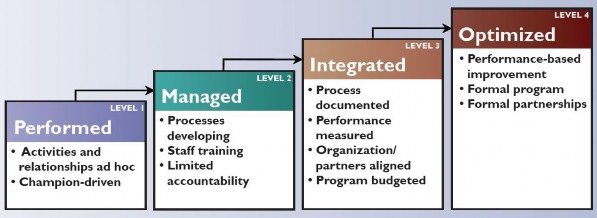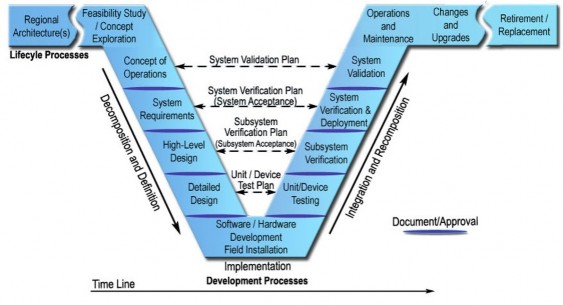Organizing for TSMO
Case Study 2: Systems and Technology – Utilizing ITS Architecture to Advance TSMO
Chapter 1 - Introduction
Historically, transportation agencies have managed congestion primarily by funding major capital projects that focused on adding capacity to address physical constraints, such as bottlenecks. Operational improvements were typically an afterthought and considered after the new infrastructure was already added to the system. Given the changing transportation landscape that includes increased customer expectations, a better understanding of the sources of congestion, and constraints in resources, alternative approaches were needed. Transportation systems management and operations (TSMO) provides such an approach to overcome these challenges and address a broader range of congestion issues to improve overall system performance. With agencies needing to stretch transportation funding further and demand for reliable travel increasing, TSMO activities can help agencies maximize the use of available capacity and implement solutions with a high benefit-cost ratio. This approach supports agencies' abilities to address changing system demands and be flexible for a wide range of conditions.
Effective TSMO efforts require full integration within a transportation agency and should be supported by partner agencies. This can be achieved by identifying opportunities for improving processes, instituting data-driven decision-making, establishing proactive collaboration, and performing activities leading to development of performance optimization processes.
Through the second Strategic Highway Research Program (SHRP2), a national partnership between the Federal Highway Administration (FHWA), the American Association of State Highway and Transportation Officials (AASHTO), and the Transportation Research Board, (TRB), a self-assessment framework was developed based on a model from the software industry. The SHRP2 program developed a framework for agencies to assess their critical processes and institutional arrangements through a capability maturity model (CMM). The CMM uses six dimensions of capability to allow agencies to self-assess their implementation of TSMO principles1:
- Business processes - planning, programming, and budgeting.
- Systems and technology - systems engineering, systems architecture standards, interoperability, and standardization.
- Performance measurement - measures definition, data acquisition, and utilization.
- Organization and workforce - programmatic status, organizational structure, staff development, recruitment, and retention.
- Culture - technical understanding, leadership, outreach, and program authority.
- Collaboration - relationships with public safety agencies, local governments, metropolitan planning organizations (MPO), and the private sector.
Within each capability dimension, there are four levels of maturity (performed, managed, integrated, and optimized), as shown in Figure 1. An agency uses the CMM self-assessment to identify their level of maturity in each dimension, to determine their strengths and weaknesses, and to determine actions they can take to improve their capabilities.
 Figure 1. Chart. Four Levels of Maturity
Source: Creating an Effective Program to Advance Transportation System Management and Operations, FHWA Jan 2012
Figure 1. Chart. Four Levels of Maturity
Source: Creating an Effective Program to Advance Transportation System Management and Operations, FHWA Jan 2012
Purpose of Case Studies
In the first 10 years of implementation of the TSMO CMM, more than 50 States and regions used the tool to assess and improve their TSMO capabilities. With the many benefits experienced by these agencies, FHWA developed a series of case studies to showcase leading practices to assist other transportation professionals in advancing and mainstreaming TSMO into their agencies. The purposes of the case studies are to:
- Communicate the value of changing the culture and standard practices towards TSMO to stakeholders and decision-makers.
- Provide examples of best-practices and lessons learned by other State and local agencies during their adoption, implementation, and mainstreaming of TSMO.
These case studies support transportation agencies by showing a wide range of challenges, opportunities, and results to provide proof for the potential benefits of implementing TSMO. Each case study was identified to address challenges faced by TSMO professionals when implementing new or expanding existing practices in the agency and to provide lessons learned.
Identified Topics of Importance
The topic of systems and technology in TSMO is important because of the unique challenges associated with it, including collaborating among different departments and areas of expertise, planning and executing implementation, and managing systems and technology. The agencies highlighted for this case study addressed those challenges through consistent collaboration, integrated intelligent transportation systems (ITS) solutions, and employing data-driven decisions.
Interviews
Agencies were selected for each case study based on prior research indicating that the agency was excelling in particular TSMO capabilities. Care was taken to include a diversity of geographical locations and agency types (departments of transportation, cities, and MPOs) to develop case studies that other agencies could easily relate to and learn from. Interviews were conducted with selected agencies to collect information on the topic for each case study.
Description of Systems and Technology
The systems and technology component of TSMO includes:
- Systems engineering.
- Regional architectures.
- ITS procurement processes
Systems engineering, in relation to ITS, assesses the value and functionality of a high-technology project, service, or system from inception to end of life. It considers what the system requires operationally throughout its lifespan, results in better project cost and schedule adherence, and ensures that stakeholder needs are met.
FHWA realized the benefit of using a systems engineering analysis (SEA) on ITS projects and, since 2001, requires that a SEA be performed on all ITS projects funded through the Highway Trust Fund. Given the diversity in ITS projects, federal regulations require the SEA be on a scale commensurate with the project scope. As a result, this provides state and local agencies flexibility in the extent of how they conduct SEA.2
Key systems engineering principles include3:
- Agreements with all stakeholders on the purpose of the project and how success will be measured.
- Stakeholder involvement from local agencies, end users, and operational staff in all milestones of project planning and delivery.
- Solutions found through using the systems engineering process rather than jumping to solutions before accurately establishing the problem.
- Technology decisions based on the best solution for the problem; the best solution may not be immediately apparent.
- When necessary, breaking the problem down into smaller components and solving each one.
- Direct relationship of all actions to the tasks before and after during project development to ensure the final product can be traced back to the needs identified at the beginning.
There are many ways to conduct a SEA. One such method is the V model as shown in Figure 2.
 The diagram notes the following steps: Regional Architecture(s), Feasibility Study/Concept Exploration, Concept of Operations, System Requirements, High-Level Design, Detailed Design, Software/Hardware Development Field Installation, Unit/Device Testing, Subsystem Verification, System Verification & Deployment, System Validation, Operations and Maintenance, Changes and Upgrades, Retirement/Replacement
Figure 2: Diagram. Systems Engineering Model
Source:https://ops.fhwa.dot.gov/publications/seitsguide/section3.htm,
FHWA, 2018
The diagram notes the following steps: Regional Architecture(s), Feasibility Study/Concept Exploration, Concept of Operations, System Requirements, High-Level Design, Detailed Design, Software/Hardware Development Field Installation, Unit/Device Testing, Subsystem Verification, System Verification & Deployment, System Validation, Operations and Maintenance, Changes and Upgrades, Retirement/Replacement
Figure 2: Diagram. Systems Engineering Model
Source:https://ops.fhwa.dot.gov/publications/seitsguide/section3.htm,
FHWA, 2018
For more information on using a SEA during ITS project deployment, see the references at the end of this document.
Methods to incorporate ITS into transportation planning vary among agencies and regions. Ensuring processes are in place to consider ITS on all projects is a key component of TSMO planning. ITS enables agencies to holistically manage the transportation network, minimizing the need for additional capacity. Operational issues, such as congestion, require operational solutions. Establishing an operational plan for ITS that identifies challenges such as staffing, procurement processes, and funding allocation, is the first step to integrating ITS into the transportation planning process. Once operational constraints and solutions have been established, a regional ITS architecture should be developed.
A regional ITS architecture is a tool to assist with planning and implementing ITS needs. It promotes regional integration and interoperability of ITS components so that projects or services are deployed in an organized manner. The regional ITS architecture should define the needs and ITS solutions or selected ITS service packages for the region. Agencies can use the National ITS Architecture (now called the Architecture Reference for Cooperative and Intelligent Transportation4 for assistance in developing their own regional plans. In addition to mobility and safety needs of the region, architectures should identify areas of ITS service gaps.
Finally, a project prioritization process or ITS Strategic Plan is established based on needs and opportunities identified during operational planning, ITS architecture development, benefit-cost ratios, and the SEA. Figure 3 shows elements used to incorporate ITS into programming.
 Figure 3. Chart. Incorporating ITS
Source: FHWA
Figure 3. Chart. Incorporating ITS
Source: FHWA